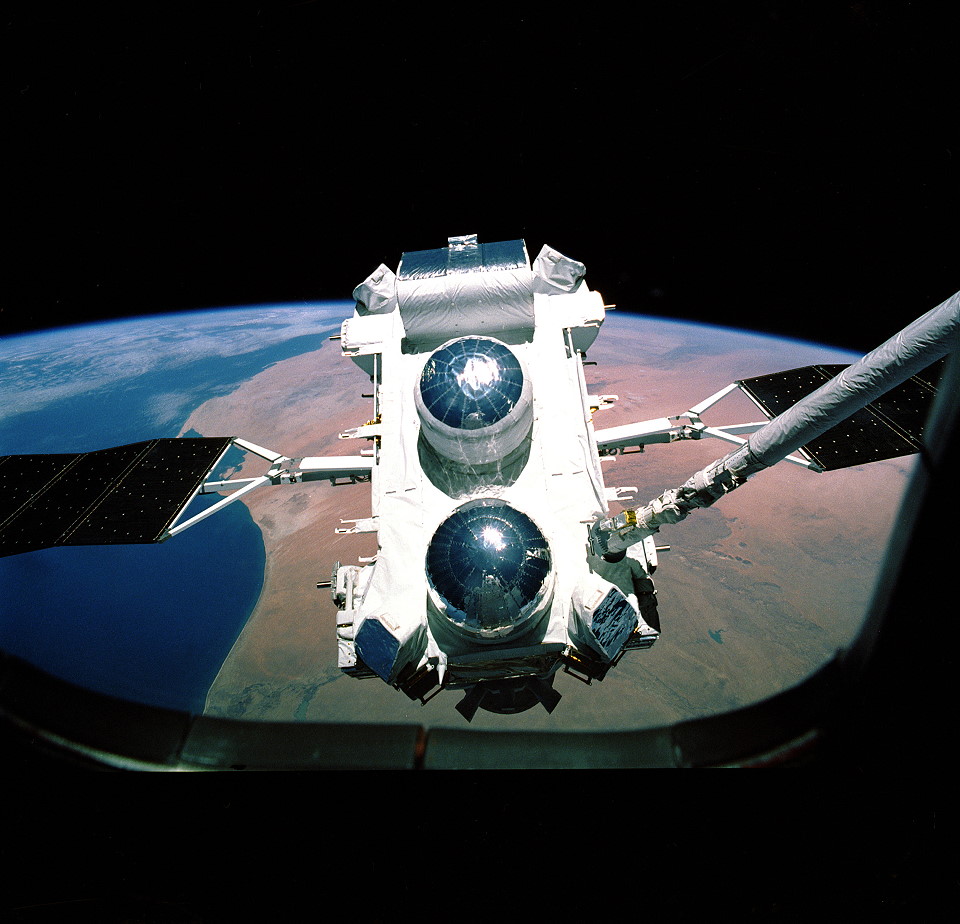
A quarter-century ago, this week, the crew of Atlantis delivered into orbit the heaviest scientific payload ever launched at that time by the space shuttle. Commander Steve Nagel, Pilot Ken Cameron, and Mission Specialists Linda Godwin, Jerry Ross, and Jay Apt successfully deployed NASA’s 35,000-pound (15,900-kg) Gamma Ray Observatory (GRO)—later renamed in honor of the Nobel Prize-winning physicist Arthur Holly Compton—and, in a unexpected twist, also supported only the second unplanned spacewalk in shuttle program history. In fact, in the months before STS-37’s April 1991 launch, the crew did not anticipate an EVA on their mission at all. By the time Atlantis returned to Earth, they had executed not one spacewalk, but two, and had saved the massive observatory from an untimely failure.
As described in yesterday’s AmericaSpace history article, the five astronauts were tasked with flying a five-day mission, during which the GRO would be deployed by means of the shuttle’s Remote Manipulator System (RMS) mechanical arm on the third day. They would then return to Earth. However, in June 1989, two months after their assignment to STS-37, NASA began work on an experimental Crew and Equipment Translation Aid (CETA), which provided a hand-propelled “cart” to maneuver astronauts along the expansive trusses of Space Station Freedom. By the time CETA received formal approval for early tests, the final payload reviews for STS-37—originally scheduled for launch in April 1990—had already taken place, but the enthusiasm of the crew led to it being added to their flight.
Due to a series of shuttle hydrogen leaks in the summer of 1990, STS-37 found itself delayed from April to November and, ultimately, into the spring of 1991. This gave the crew more time to prepare for a spacewalk, which would involve the movement of a CETA cart along a 45-foot (14-meter) extendible track in the shuttle’s payload bay. Manual, mechanical, and electrical methods of operating the hardware would be trialed. In fact, Jerry Ross had performed the most recent EVA in the shuttle program, on Mission 61B in the fall of 1985, just weeks before the Challenger tragedy. Yet the paucity of EVA experience in the Astronaut Office at the time was such that Ross expected Godwin and Apt to be handed the assignment. Commander Nagel, however, thought differently.
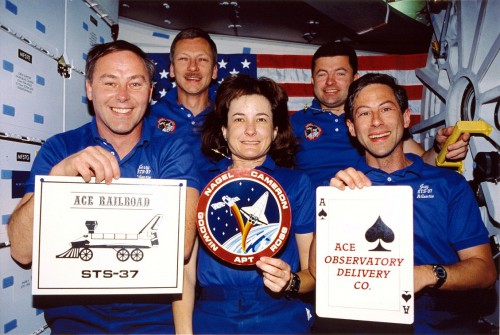
Nagel’s concern was not so much centered on the CETA task, but upon a possible secondary EVA objective: If anything went wrong with the $630 million GRO during deployment, a contingency spacewalk might be needed to save it. “I’d look really stupid,” he told Ross, as paraphrased in his NASA oral history interview, “if we had to do some kind of contingency EVA on a primary payload and you weren’t one of the two guys that was outside!” It was decided and Ross and Apt pressed ahead with preparations for what was expected to be a single EVA for CETA trials.
Liftoff of STS-37 took place at 9:22 a.m. EDT on 5 April 1991. “Entirely nominal and entirely exciting,” was Ken Cameron’s summary of his first launch into space. Two days later, from an orbit of 280 miles (450 km), the massive GRO hung above Atlantis’ payload bay at the end of the RMS arm, ready for deployment. To preserve the opportunity for Ross and Apt to go outside on a contingency EVA, the shuttle’s cabin had been depressurized and their space suits and the airlock had been checked out and were ready. As the crew watched, GRO’s two solar array “wings” were successfully unfurled.
At this point, Apt glanced over at Ross. “I guess everything’s downhill from here!” It was true: Deployment of the accordion-like solar arrays, which reached a total wing span of 65 feet (20 meters), was one of their key worries. Next came the deployment of GRO’s high-gain antenna, which would provide high-rate communications with ground stations. Commands were issued for it to extend on its 10-foot (3-meter) boom.
But it did not move.
No fewer than six attempts were made to unfurl it, and Nagel and Cameron even tried shaking it open with a burst of the shuttle’s maneuvering thrusters. From the RMS controls, Godwin tried moving the arm relatively sharply, then halting relatively abruptly, but her efforts also had no effect. A contingency EVA was the only option. Ross removed his wedding ring and handed it to Nagel. “Steve,” he said to his long-time friend and fellow Air Force flier, “I’m going downstairs to get ready.”
Nagel nodded. A few minutes later, the call came from Mission Control for the spacewalkers to do just that. Entering the payload bay, Ross later reflected that his level of anxiety on this occasion was heightened by the urgency of fixing GRO. “I didn’t know if we could fix it or not,” he told NASA’s oral historian, “and here we are, on the spot, to try to go out and fix this thing. And if we can’t, then we’ve got this great big lead weight. What are we going to do with it? We may not be able to bring it home, because the solar array’s already been deployed and the antenna’s partly released. Oh, man!”
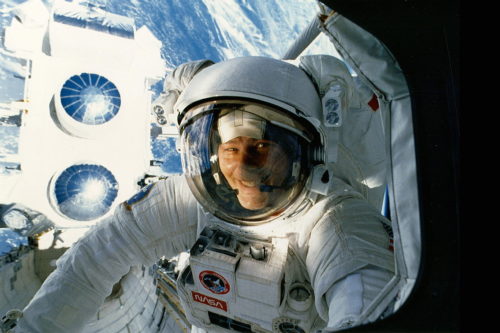
Quickly, the two spacewalkers split up: Apt moved to the port side of the payload bay to set up tools, whilst Ross, on the starboard side, attended to the task at hand. Godwin moved the robot arm slightly to tilt the GRO toward him. “The antenna,” Ross said, “was on the back side, facing the aft bulkhead of the orbiter, and the guys in the cockpit couldn’t see it from the aft windows.” By the time he reached the location of the antenna, Atlantis was passing out of direct communication with Mission Control and Ross used the quiet time to position himself in such a way that he could shake it open. He knew that the antenna was relatively close to GRO’s hydrazine tanks, and he definitely did not want to ding them and risk having a highly-toxic leakage on his hands. By now Nagel, Cameron, and Godwin were getting views from the aft payload bay cameras on their monitors and were able to offer Ross additional guidance.
He gave the antenna a couple of lateral shakes. It still felt solid; immovable. A few more tries, which Ross later described as “some relatively easy force-inputs,” achieved a measure of success, as it started to loosen up a little.
“I was probably putting in 45-50 pounds of force, is my recollection,” Ross said later, “and I could tell it was starting to walk out. Finally, it came free and swung out about 30-40 degrees from the stowed position.” It turned out that a thermal blanket had become “hung up” on a bolt, and Ross’ repair had taken just 17 minutes. He let out “a war whoop” and returned to the port side of the bay to join Apt. The two men gathered their tools, and Ross returned to GRO to begin the process of manually locking the antenna’s boom into its deployed position. “And that was a pretty good feeling,” he said. “I felt that I’d probably earned my keep for that day!”
At one stage, Ross took a breather, moving close to Atlantis’ aft flight deck windows to grin at his crewmates inside the cockpit. Nagel snapped his photograph.
At 5:36 p.m. EDT on 7 April, some three orbits and more than 4.5 hours later than planned, Godwin finally released a perfectly functioning GRO from the grasp of the arm. NASA’s second Great Observatory, with all the grace of a space-age diesel locomotive, drifted serenely away into the inky blackness to commence its mission. Ross and Apt had a ringside seat for much of this activity, for they were able to remain outside whilst the final checks on the observatory were performed. “During that period of time,” Ross told the oral historian, “Jay and I were allowed to stay outside on the spacewalk and to do a series of force measurements.” The intention was to understand the kind of loads an astronaut might experience whilst in and out of a foot restraint and Ross performed “a whole series of maneuvers of turning wrenches, turning handles, maneuvering myself … a whole series of things that we were recording the data so that we could get more information.” Years later, Ross remembered working up a vigorous sweat, which streamed into his eyes at one stage, such was the level of exertion and exhaustion.
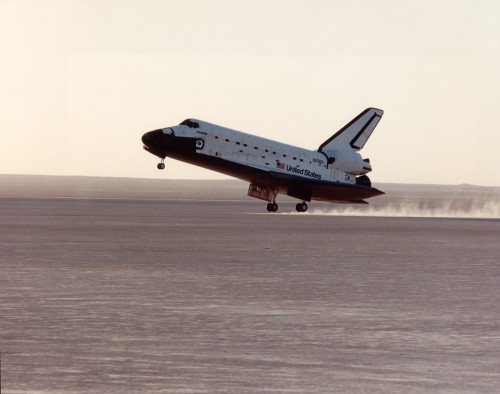
The spacewalkers were supposed to be back inside Atlantis’ airlock in time for the actual GRO release. It did not entirely work out that way. “I think the only thing that was still in the airlock when we released the satellite,” said Ross, “were our toenails! Jay and I were pretty well outside of the hatch … and then they fired the jets to move the orbiter away. That was really cool. We were over North Africa at the time that we released it and we were above the satellite, looking down. That was a pretty awesome sight.”
Ross and Apt prepared dinner for their crewmates that night to celebrate a remarkable day. Yet STS-37 had barely reached its halfway point. On 8 April, the spacewalkers returned outside for their originally planned six-hour EVA to perform a series of Space Station Freedom locomotion tests with the Crew and Equipment Translation Aid (CETA). A 24-hour delay to their landing, caused by bad weather at Edwards Air Force Base, meant that they finally returned home to California on the 11th, after six days in space.
During his final approach, Nagel fell victim to an incorrect call on high-altitude winds and brought the orbiter down onto the runway, about 620 feet (190 meters) “short” of the threshold. It was the first “low-energy” landing of the shuttle program and was not immediately noticeable to most spectators, since it was on the vast dry lakebed of Edwards Runway 17, but gained a lot of attention from Nagel’s fellow astronauts.
Years later, Nagel would blame himself for not being sufficiently aggressive when he rolled out onto final approach, but it made little difference to his career. His first shuttle command had triumphed in the face of adversity, placed a brand-new Great Observatory, fully functional, into orbit, and had gone a long way toward demonstrating not only that NASA needed a permanent space station, but that it needed the capabilities of men and women in space.
This is part of a series of history articles, which will appear each weekend, barring any major news stories. Next week’s article will focus on the 35th anniversary of STS-1, the maiden voyage of the Space Shuttle Program and arguably one of the most hazardous human space missions ever attempted.
Be sure to “Like” AmericaSpace on Facebook and follow us on Twitter: @AmericaSpace




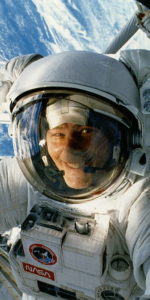
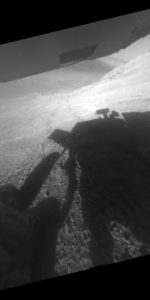
Hacked on facebook on Twitter